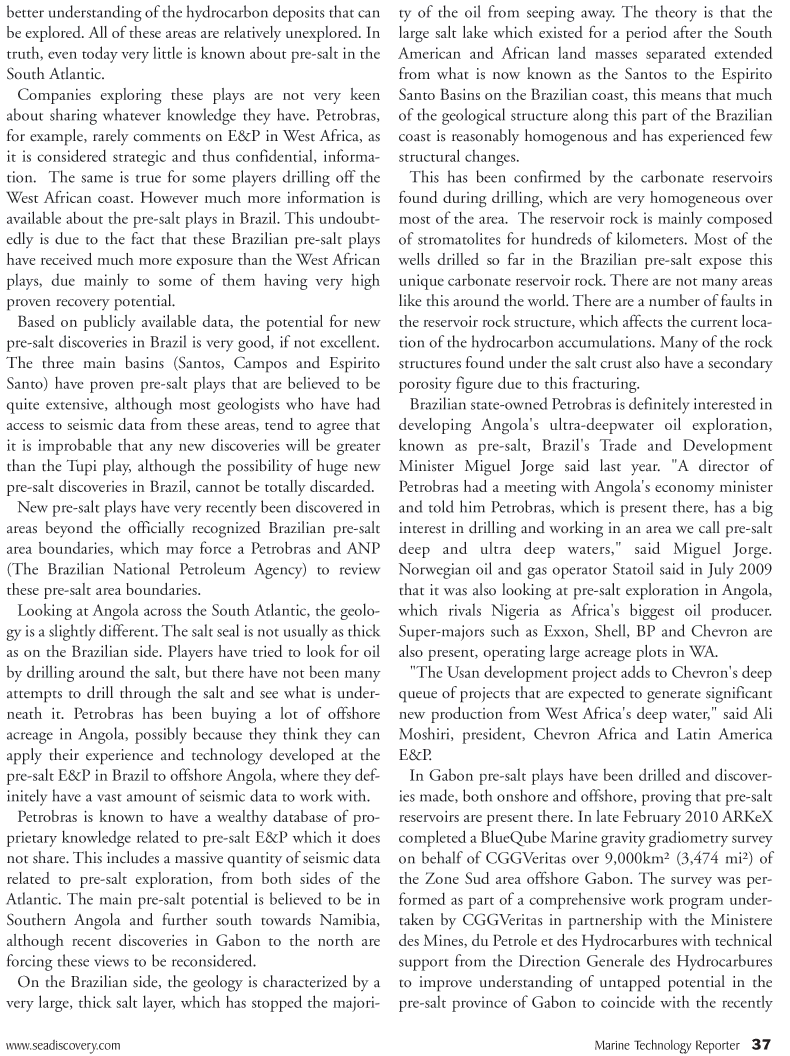
Page 37: of Marine Technology Magazine (September 2010)
Ocean Observation
Read this page in Pdf, Flash or Html5 edition of September 2010 Marine Technology Magazine
www.seadiscovery.com Marine Technology Reporter 37 better understanding of the hydrocarbon deposits that can be explored. All of these areas are relatively unexplored. In truth, even today very little is known about pre-salt in the
South Atlantic.
Companies exploring these plays are not very keen about sharing whatever knowledge they have. Petrobras, for example, rarely comments on E&P in West Africa, as it is considered strategic and thus confidential, informa- tion. The same is true for some players drilling off the
West African coast. However much more information is available about the pre-salt plays in Brazil. This undoubt- edly is due to the fact that these Brazilian pre-salt plays have received much more exposure than the West African plays, due mainly to some of them having very high proven recovery potential.
Based on publicly available data, the potential for new pre-salt discoveries in Brazil is very good, if not excellent.
The three main basins (Santos, Campos and Espirito
Santo) have proven pre-salt plays that are believed to be quite extensive, although most geologists who have had access to seismic data from these areas, tend to agree that it is improbable that any new discoveries will be greater than the Tupi play, although the possibility of huge new pre-salt discoveries in Brazil, cannot be totally discarded.
New pre-salt plays have very recently been discovered in areas beyond the officially recognized Brazilian pre-salt area boundaries, which may force a Petrobras and ANP (The Brazilian National Petroleum Agency) to review these pre-salt area boundaries.
Looking at Angola across the South Atlantic, the geolo- gy is a slightly different. The salt seal is not usually as thick as on the Brazilian side. Players have tried to look for oil by drilling around the salt, but there have not been many attempts to drill through the salt and see what is under- neath it. Petrobras has been buying a lot of offshore acreage in Angola, possibly because they think they can apply their experience and technology developed at the pre-salt E&P in Brazil to offshore Angola, where they def- initely have a vast amount of seismic data to work with.
Petrobras is known to have a wealthy database of pro- prietary knowledge related to pre-salt E&P which it does not share. This includes a massive quantity of seismic data related to pre-salt exploration, from both sides of the
Atlantic. The main pre-salt potential is believed to be in
Southern Angola and further south towards Namibia, although recent discoveries in Gabon to the north are forcing these views to be reconsidered.
On the Brazilian side, the geology is characterized by a very large, thick salt layer, which has stopped the majori- ty of the oil from seeping away. The theory is that the large salt lake which existed for a period after the South
American and African land masses separated extended from what is now known as the Santos to the Espirito
Santo Basins on the Brazilian coast, this means that much of the geological structure along this part of the Brazilian coast is reasonably homogenous and has experienced few structural changes.
This has been confirmed by the carbonate reservoirs found during drilling, which are very homogeneous over most of the area. The reservoir rock is mainly composed of stromatolites for hundreds of kilometers. Most of the wells drilled so far in the Brazilian pre-salt expose this unique carbonate reservoir rock. There are not many areas like this around the world. There are a number of faults in the reservoir rock structure, which affects the current loca- tion of the hydrocarbon accumulations. Many of the rock structures found under the salt crust also have a secondary porosity figure due to this fracturing.
Brazilian state-owned Petrobras is definitely interested in developing Angola's ultra-deepwater oil exploration, known as pre-salt, Brazil's Trade and Development
Minister Miguel Jorge said last year. "A director of
Petrobras had a meeting with Angola's economy minister and told him Petrobras, which is present there, has a big interest in drilling and working in an area we call pre-salt deep and ultra deep waters," said Miguel Jorge.
Norwegian oil and gas operator Statoil said in July 2009 that it was also looking at pre-salt exploration in Angola, which rivals Nigeria as Africa's biggest oil producer.
Super-majors such as Exxon, Shell, BP and Chevron are also present, operating large acreage plots in WA. "The Usan development project adds to Chevron's deep queue of projects that are expected to generate significant new production from West Africa's deep water," said Ali
Moshiri, president, Chevron Africa and Latin America
E&P.
In Gabon pre-salt plays have been drilled and discover- ies made, both onshore and offshore, proving that pre-salt reservoirs are present there. In late February 2010 ARKeX completed a BlueQube Marine gravity gradiometry survey on behalf of CGGVeritas over 9,000km² (3,474 mi²) of the Zone Sud area offshore Gabon. The survey was per- formed as part of a comprehensive work program under- taken by CGGVeritas in partnership with the Ministere des Mines, du Petrole et des Hydrocarbures with technical support from the Direction Generale des Hydrocarbures to improve understanding of untapped potential in the pre-salt province of Gabon to coincide with the recently

 36
36

 38
38
